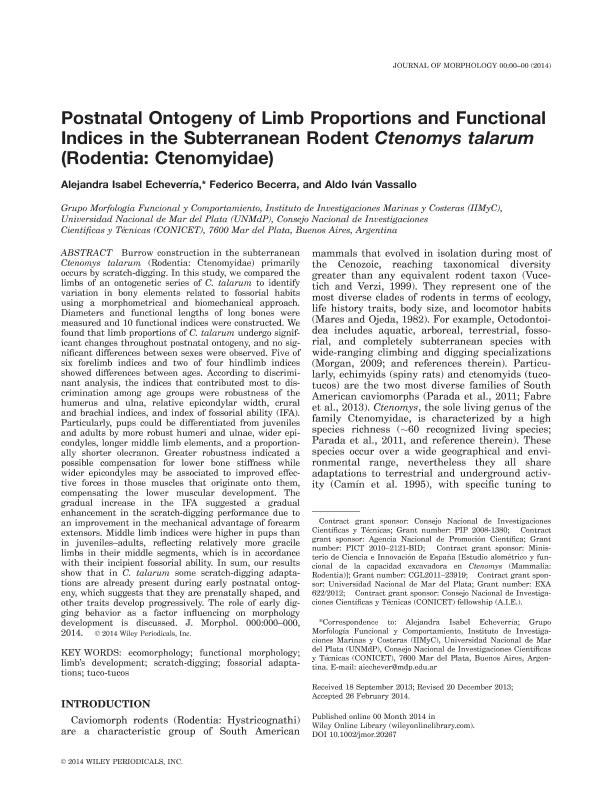Artículo
Postnatal ontogeny of limb proportions and functional indices in the subterranean rodent Ctenomys talarum (Rodentia: Ctenomyidae)
Fecha de publicación:
05/2014
Editorial:
Wiley-liss, Div John Wiley & Sons Inc
Revista:
Journal of Morphology
ISSN:
0362-2525
Idioma:
Inglés
Tipo de recurso:
Artículo publicado
Clasificación temática:
Resumen
Burrow construction in the subterranean Ctenomys talarum (Rodentia: Ctenomyidae) primarily occurs by scratch-digging. In this study, we compared the limbs of an ontogenetic series of C. talarum to identify variation in bony elements related to fossorial habits using a morphometrical and biomechanical approach. Diameters and functional lengths of long bones were measured and 10 functional indices were constructed. We found that limb proportions of C. talarum undergo significant changes throughout postnatal ontogeny, and no significant differences between sexes were observed. Five of six forelimb indices and two of four hindlimb indices showed differences between ages. According to discriminant analysis, the indices that contributed most to discrimination among age groups were robustness of the humerus and ulna, relative epicondylar width, crural and brachial indices, and index of fossorial ability (IFA). Particularly, pups could be differentiated from juveniles and adults by more robust humeri and ulnae, wider epicondyles, longer middle limb elements, and a proportionally shorter olecranon. Greater robustness indicated a possible compensation for lower bone stiffness while wider epicondyles may be associated to improved effective forces in those muscles that originate onto them, compensating the lower muscular development. The gradual increase in the IFA suggested a gradual enhancement in the scratch-digging performance due to an improvement in the mechanical advantage of forearm extensors. Middle limb indices were higher in pups than in juveniles–adults, reflecting relatively more gracile limbs in their middle segments, which is in accordance with their incipient fossorial ability. In sum, our results show that in C. talarum some scratch-digging adaptations are already present during early postnatal ontogeny, which suggests that they are prenatally shaped, and other traits develop progressively. The role of early digging behavior as a factor influencing on morphology development is discussed
Archivos asociados
Licencia
Identificadores
Colecciones
Articulos(IIMYC)
Articulos de INSTITUTO DE INVESTIGACIONES MARINAS Y COSTERAS
Articulos de INSTITUTO DE INVESTIGACIONES MARINAS Y COSTERAS
Citación
Echeverría, Alejandra Isabel; Becerra, Federico; Vassallo, Aldo Iván; Postnatal ontogeny of limb proportions and functional indices in the subterranean rodent Ctenomys talarum (Rodentia: Ctenomyidae); Wiley-liss, Div John Wiley & Sons Inc; Journal of Morphology; 275; 8; 5-2014; 902-913
Compartir
Altmétricas




